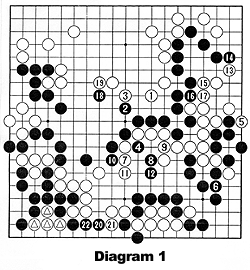Fujitsu Cup
The final game of this year's Fujitsu Cup, jointly sponsored by Fujitsu Ltd. and The Yomiuri Shimbun, was held on Aug. 7 in Tokyo. This year's finalists were two previous winners of this cup, Yoo Chang Hyuk of South Korea and Ma Xiaochun of China. Both had won this cup once before (Yoo in 1993; Ma in 1995). It was clear that both players were determined to win, and no one was sure until the very end who would be the victor.
Ma (playing white) staked out more than 60 points of territory at the top with move 128 (1 in Diagram 1). This was more than Yoo had on the right side and the lower left corner. But Yoo then attacked the white stones on the left side forcing them to make eyes with the sequence to White 17. Next, he staked out territory in the middle with Black 18, forcing White to defend his own territory with 19. Black then played 20 at the bottom. White had no choice but to engulf the marked black stone with 21, so Black was able to link up with his two stones at the bottom with 22, thereby cutting off the four marked white stones at lower left. Since these white stones could no longer avoid capture, the game was close.
A hard-fought endgame ensued and the game ended after 244 moves, with Black emerging the victor by the merest of margins-half a point.
This was Yoo's third international title. Besides his earlier victory in the 1993 Fujitsu Cup, he also won the $400,000 Ing Changki Cup in 1996, and has been runner-up in five other international tournaments. Over the last three years, he seems to have been in a slump, but with his victory over Ma, who is considered to be the world's second best player behind the great Lee Chang Ho, Yoo has proven himself to be back in form and one of the top players in the world. In South Korea, only Lee Chang Ho and Cho Hoon Hyun are ranked above him.
For their efforts, Yoo received 20 million yen and Ma 7 million yen. Satoru Kobayashi received 4 million yen for his victory over Cho Chikun in the game that determined third place.
Meijin challenger
The nine player round-robin tournament to decide the challenger to the Meijin title holder, Cho Chikun, ended on Aug. 5 with three players having identical scores of six wins to two losses. According to the rules of this tournament, the two highest ranked players, Koichi Kobayashi and Norimoto Yoda, met in a playoff to decide who would be the challenger. Both are considered to be strong contenders. Kobayashi represents the old guard, while Yoda, who is only 33, is expected to be one of the leading players when Kobayashi and Cho pass their primes. Kobayashi held the Meijin title for seven consecutive years (from 1988 to 1994) and has played Cho in numerous best-of-seven title matches, while Yoda has faced Cho only once, in the Yomiuri-sponsored 1998 Kisei title match. In the hard-fought playoff, Yoda, playing Black, eked out a win by half a point.This title match is expected to be a milestone for both Yoda and Cho. If Cho loses, it could signal the end of his dominance, while if Yoda wins, it could be the prelude to his own emergence as Japan's top player. After having lost his Honinbo title last month to a relatively unknown player, Cho will be out to prove that he is still the top player in Japan. Yoda, on the other hand, will want to show that he is not just an ordinary player who wins a few minor titles, but cannot meet the challenge for the big ones. For these reasons, the upcoming title match promises to feature some hard-fought games.
A capturing race
In the game in Diagram 1, Black 20 was a powerful move that enabled Yoo to equalize the balance of territories. When White protected the right side with 21, Black linked up with 22. A capturing race was now set up between the four marked white stones and the three black stones on the right.
However, Black's three stones had four liberties (points A in Diagram 2) to White's three liberties (points B). Therefore, Black wins this capturing race. For example, if White plays first, he might exchange 1 for 2 in Diagram 3, then start to fill up the liberties of the black stones with White 3. Black fills one of White's liberties with 4, and the race to capture continues until Black captures the four white stones with 8.

Suppose White answered Black 20 in Diagram 1 by playing at 1 in Diagram 4, In that case, Black would link up with 2. Again, the marked white stones on the left have only three liberties (points A) to Black's four.

White loses the capturing race as shown in Diagram 5, but in this sequence he loses six stones instead of the four lost in Diagram 3. Therefore, White defended the bigger territory on the right with 21 in Diagram 1.

The placement of Black 20 in Diagram 1 was a skillful tactical move that wrested the territory at the bottom from White. However, the timing of this move was crucial. If Black had played it too soon, without first having exchanged 18 for 19, White would have gotten too much territory at the top. Black 18 acted as a stumbling block, preventing White from expanding his territory at the top and giving Black some territory in the center.
This game was a cliff-hanger which could have gone either way and was a fitting conclusion to this year's world championship.
